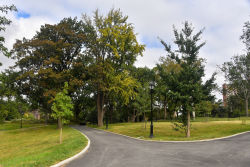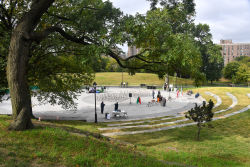St. Mary's Park
Gil Scott-Heron Amphitheater
What was here before?
This site was once part of the estate of Jonas Bronck (1600-43), for whom the Bronx is named. Later, the land was held by the family of Gouverneur Morris (1752-1816), an author of the U.S. Constitution. After 1857, the area was known as “Janes’ Hill” for owner Adrian Janes of Janes, Kirtland & Co. Iron Works, a local foundry that fabricated the U.S. Capitol dome.
How did this site become an amphitheater?
St. Mary’s was one of six major Bronx parks created in 1888. The park’s landscaping took advantage of the rugged natural terrain. Improvements included the borough’s first playground, athletic fields, tennis courts, a farm garden, and a year-round recreation center. In the late 20th century, the amphitheater area was paved over for use as tennis courts and occasional performances or public assemblies.
Located on a plateau east of the recreation center, the amphitheater—designed by Starr Whitehouse landscape architects and completed in 2021—serves as a multi-use space able to adapt to large-scale concerts as well as more modest performances and events. It is nestled into the natural topography with native plants beautifying the entryways.
A large oval-shaped paved plaza with two-toned hex pavers accommodates spectators and a mobile performance stage. Four tiers of rough-hewn granite seating separated by lawn panels are embedded into the adjacent hillside. The amphitheater can hold crowds up to 5,000. Since 2002 the City Parks Foundation’s Summerstage has mounted a concert series of broadly ranging musical genres, and also staged dance and theater events, puppet shows, and children’s programs.
Who is this amphitheater named for?
In 2021, as part of the second phase of NYC Parks’ initiative to expand the representation of African Americans honored in parks, this amphitheater was named for Gil Scott-Heron (1949-2011) a pioneering soul and jazz poet, musician, and author.
Scott-Heron was born in Chicago to Bobbie Scott and Gilbert Heron. After they separated, he lived with his grandmother in Tennessee where he learned to play the piano. His grandmother died when he was twelve, and he reunited with his mother in the Bronx.
Scott-Heron enrolled in DeWitt Clinton High School where his English teacher recommended him for a scholarship at the prestigious Fieldston School, where he was one of only five Black students. He enrolled in Lincoln University, a historically Black college, where he met the Last Poets. The group, early influencers on hip hop music, was performing at Lincoln, and Scott-Heron formed a band of his own. Scott-Heron received his master’s degree from Johns Hopkins University, and taught writing at Federal City College, now University of the District of Columbia.
In 1970, he published The Vulture, a well-received murder mystery, and the song poem The Revolution Will Not Be Televised, which was a popular slogan during the Black Power movement. In 1975, Scott-Heron was signed to Arista Records by Clive Davis where he released nine albums until 1985, starting with The First Minute of a New Day. Scott-Heron developed serious health problems, including addiction. A year before his death in 2011, he released his last album on XL Recordings, I’m New Here, which debuted in the Billboard top 200.
In 2012, he was posthumously awarded a Grammy for Lifetime Achievement, and in 2021 he was inducted into the Rock & Roll Hall of Fame in the Early Influencer category. While Scott-Heron is often called the Godfather of Rap, he preferred to be known as a “bluesologist.”
Check out your park's Vital Signs
Clean & Safe
Green & Resilient
Empowered & Engaged Users
Share your feedback or learn more about how this park is part of a
Vital Park System

Know Before You Go
Anticipated Completion: Fall 2023









